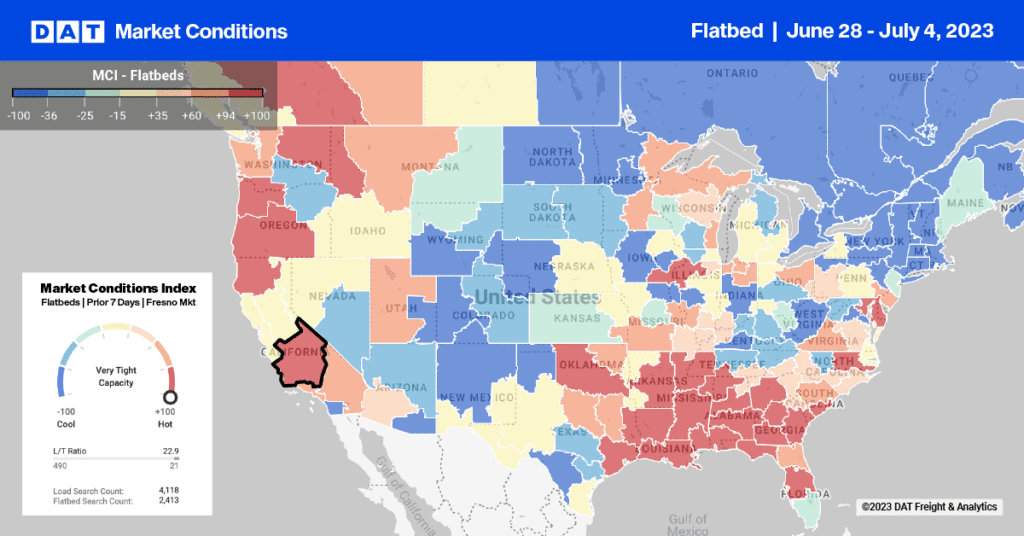To identify trihaul routes quickly and run them successfully, we recommend using Truckload Rate Index with Spot Market Rates. If you don’t have resources to implement trihaul routes in-house, you might want to share this report with your favorite freight broker.
Here’s how it works: You already have a load from Point A to Point B – let’s say it’s a weekly van load from Chicago to Dallas. You need a backhaul to Chicago, to re-position your truck in time for the next outbound trip on Monday. There’s a problem: Loads from Dallas to Chicago don’t pay much. At the end of May, brokers were paying an average of $1.36 per mile — $0.87 for the linehaul, plus a $0.49 fuel surcharge. That is better than a deadhead, but it doesn’t add much to your bottom line.

This screen shot from Truckload Rate Index shows the spot market rate for the lane from Arlington TX to Chicago. At $1.36 per mile, including the fuel surcharge, a backhaul from Dallas to Chicago is not profitable for most carriers. Add a leg to almost any major city that fits into your schedule, to create a trihaul route that improves your round-trip revenues and profitability.
If you have a regular route with a low-paying backhaul like the one from Dallas to Chicago, you’re in a great position to experiment with trihaul routing. Why? Because almost any trihaul route will offer a better rate than a straight backhaul. With Truckload Rate Index and a spreadsheet program like Microsoft Excel, you can identify the best trihaul routes in about an hour.
- Define a radius for your preliminary search.
Look up mileage and rates from the Dallas metro area to cities that are 250 to 1,000 miles away. (We chose Arlington TX, a typical backhaul location, and found 60 cities that fit those criteria.) Eliminate cities that are less than 250 miles from Chicago. (That left 53.) Then look up the rates from each of those cities to Chicago, using the bulk rate feature of Truck Load Rate Index – Spot Market Rates. Remember to add the fuel surcharge at the end. - Identify the top-performing lane pairs.
Set up a spreadsheet so that the paired lanes and rates are displayed side-by-side. Compute the total miles, rate per mile, total revenues, and estimated days or hours, to accommodate your schedule and the driver’s HOS. Then sort and compare all the trihaul routes to the backhaul route. At the end of May, all of the potential trihaul routes yielded a better total return than a straight backhaul to Chicago. Four of the 53 cities yielded a lower average rate per mile on the trihaul than you would get for a straight backhaul to Chicago: Lexington, Huntington, Louisville and Cincinnati. - Prioritize your selections.
You might not want to pursue the highest-paying lane. Why not? In our example, the highest paying lanes showed an average rate of $1.75 including fuel, to Jacksonville FL, and $1.74 to either Albany GA, Mobile AL or San Antonio TX. Jacksonville is too far. Mobile looks pretty good. (See map, below.) San Antonio might also be a good choice, even though the first leg takes you in the “wrong” direction. If you are short on time, sort your spreadsheet by estimated number of days to complete the trip, and consider Little Rock, Wichita, Tulsa, Omaha or Des Moines. Each one will add 30% to 37% in incremental revenue to your return trip. - Find loads to and from your top city choices.
Now search for loads, starting with your top five or six cities. You will want two loads to cover the return trip for each trihaul route, so this part of the exercise may take longer than usual – but it’s worth the extra time. Check your load board and talk to brokers, then compare the rates that are actually being offered to the rates on your spreadsheet. (Don’t forget the fuel surcharge!) When you get two loads to cover your return trip, for more money than you would make on a straight backhaul, you have a new trihaul route. - Repeat successful routes and try new ones.
Build on your successes and develop a list of trihaul routes that complement your regular contract hauls and lanes. You may even want to position some of your assets to take advantage of seasonal trihaul opportunities in different markets or regions.

Dallas to Chicago is typically a low-paying backhaul. By adding a second leg with a delivery in another city such as Mobile AL, you can convert your return trip into a profitable trihaul route.


